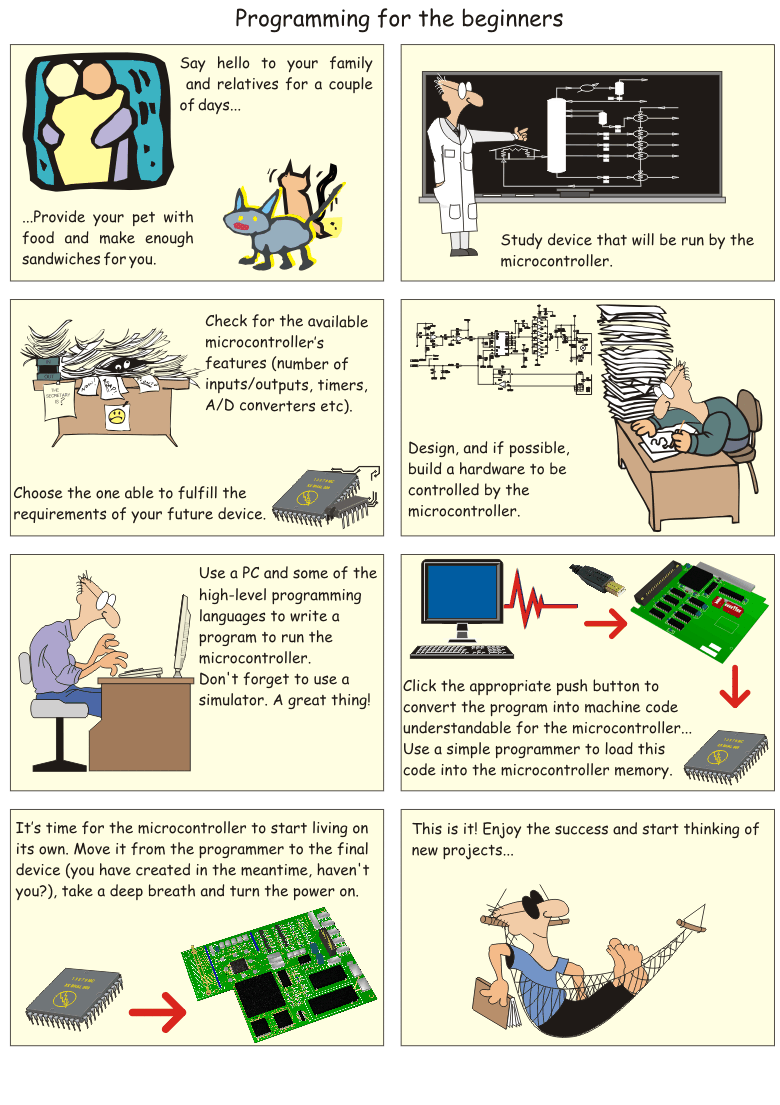1.1 Introduction
Novices in electronics usually think that the microcontroller is the same as the microprocessor. That's not true. They differ from each other in many ways. The first and most important difference in favour of the microcontroller is its functionality. In order for the microprocessor to be used, other components, first of all memory, must be added to it. Even though it is considered a powerful computing machine, it is not capable of establishing direct communication with the peripherals. Instead, specialized circuits must be used for this purpose. This is how it was in the beginning and remains the same today.
On the other hand, the microcontroller is designed to be all of that in one. No other specialized peripheral components are needed for its operation as all necessary circuits, which otherwise belong to peripherals, have been already built into it. It saves both time and space required when designing a device.
ALL THE MICROCONTROLLER IS CAPABLE OF
Microcontrollers are very popular nowadays. Just pay attention to the example below and you will understand the reasons for their great success. It won't take up much of your time, just a couple of minutes. Around ten years ago, the process of designing an electronic device controlling an elevator in a multistory building was extremely difficult, even for a team of experts. Have you ever thought of what requirements an ordinary elevator has to meet? How to deal with situation when two or more people call the same elevator at the same time? Which call has the priority? How to handle the security questions? Loss of electricity? Operation failure? Misuse? After solving these basic questions, a tough process of designing an appropriate electronics using a large number of special-purpose chips comes next. Depending on the device complexity, such process can take weeks, even months. Then it's time to make a printed circuit board and assemble device. A huge device! It is another long-lasting and trying work. Finally, when your device is finished and tested many times, the crucial moment comes. The moment when you take a deep breath and switch the power supply on. The party is over at this point as electronic devices almost never start to operate immediately. Get ready for many sleepless nights, corrections, improvements... and don't forget, we are still talking about running an ordinary elevator. When your device finally works perfectly and everybody is satisfied and you get paid for the work you have done, other constructing companies will become interested in your work. Of course, if you are lucky, another day will bring you a locking offer from a new investor. A new building has four stories more. You know what it is all about? You think you can control destiny? You are going to make a universal device which can be used in buildings of 4 to 40 stories, a masterpiece of electronics? Even if you manage to make such an electronic jewel, your investor will wait in front of your door asking for a camera in the elevator. Or for relaxing music in case of elevator failure. Or for a two-door elevator. Anyway, Murphy's law is inexorable and you will certainly not be able to make advantage of all the effort you have made. Unfortunately, everything said so far is true. This is what 'handling electronics' really means. No, no, wait, let us correct ourselves, this is how it was until the first microcontrollers were designed - small, powerful and cheap devices. Since the moment their programming stopped being a science, everything went in another direction... Electronics capable of controlling a small submarine, a crane or an elevator are now built into one single chip. Microcontrollers offer a wide range of applications, but only a few of them are normally used. It's up to you to decide what you want from the microcontroller and dump a program accordingly containing appropriate instructions into it. Prior to turning the device on, its operation should be tested by simulation. If everything works fine, build the microcontroller into your device. If you ever need to change, improve or upgrade the program, just do it. Until when? Until you feel satisfied. That's all.




